For Raya and the Last Dragon, the influences of a multitude of Southeast Asian cultures are apparent. For directors Don Hall and Carlos López Estrada, and writer Qui Nguyen, it was important to bring to light a culture that is often unseen at on a large scale. From the use of Thai martial arts to Filipino weapons such as the Arnis, the inclusion of specific aspects of Southeast Asian culture helped to bond the amalgamation that was Kumandra.
DEADLINE: How did you come up with the concept and story for Raya?
QUI NGUYEN: The movie had been in development for quite a few years, so by the time it got to us, there were definitely some strong themes there and we knew that it would be a movie about Southeast Asia, and one that had to do with dragons and one that was ultimately about unity, and with a female warrior character. A lot of the work and research was creating Kumandra, a Southeast Asian world, specifically when it came to the filmmaking of it all, there was definitely inspiration from a lot of East Asian martial arts films and stuff like that.
DEADLINE: For the world of Kumandra, you mentioned a lot of Southeast Asian influences. Were there specific influences or was it a general amalgamation of culture?
NGUYEN: It was specific in that we were having conversations with cultural consultants from different countries, but general in the sense that we were trying to take the universal themes from the different countries that we all shared. I say we, because I’m also Southeast Asian. We often talk about how made it general so we didn’t to fall into the trope of having the “good guy” country, say Vietnam for example, and having another country be the “bad guy” country. But when it came to the specifics of like clothes, weapons, era, and things like that, we were very specific. Not specific in the sense that we were making a weapon that was Vietnamese/Filipino. No, it was getting to be like those Arnis stick weapons for Filipinos, that sword was Malaysian that, and that martial art was Thai, and the way they took that person down was Vietnamese. We were using very specific things, so when you saw it, it became like Easter eggs to the culture. Someone like myself, or someone who is from the region, could that head nod to go, “Hey, we see you and we acknowledge you. This is for you.”
DEADLINE: How did the pandemic affect the movie?
CARLOS LÓPEZ ESTRADA: Because we knew that the movie had to come at a certain time, we essentially had maybe two days off and then kept working from home. Our technology team did an incredible job in allowing all of us to continue working. I think what was most difficult is that I was brand new to the Disney animation experience in Qui had been there for, I think, over a year, but it was still relatively new for him as well. But the culture is really about collaboration. And what we do as directors is we sit in our big story rooms and we meet with story artists and we meet with designers and we meet amongst ourselves to talk about everything, to whiteboard, to look at visual references, and to surround ourselves with images. Obviously, we couldn’t have that, which I think was the scariest thing about working from home. But because people really believe that this was an important story to tell, we were able to maintain that sense of unity, and we were able to maintain that sense of us walking in the same direction. Even though we had 500 people working from 500 different homes at any given time, it really felt like we were a unified vision.
Must Read Stories
‘Cal Fire’ Drama From Max Thieriot, Tony Phelan, Joan Rater & Bruckheimer TV In Works At CBS
Mel Gibson In Talks To Direct ‘Lethal Weapon 5’, Which Would Be Developed For HBO Max
Marc Weinstock President Of Worldwide Marketing & Distribution; Pam Kaufman To Run Themed Entertainment Unit
Dick Wolf Podcast ‘Dark Woods’ Gets TV Adaptation From Universal Television
Read More About:
Source: Read Full Article




